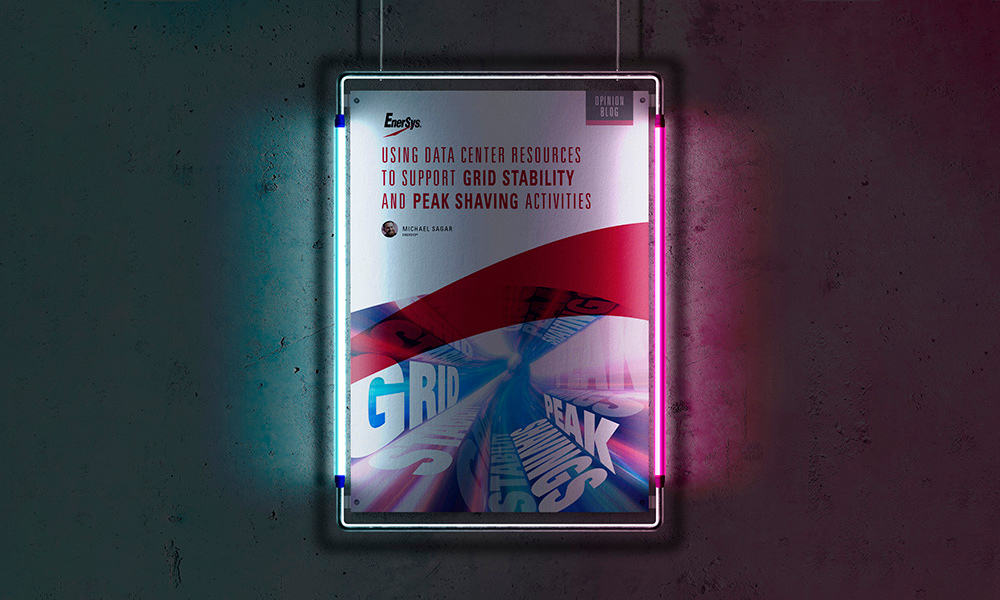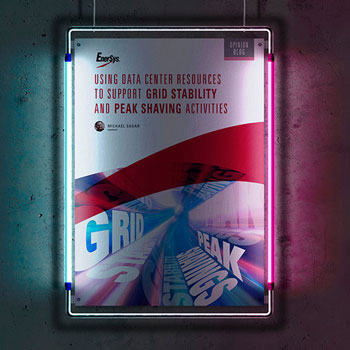Using Data Center Resources to Support Grid Stability and Peak Shaving Activities

If our society is going to successfully reduce carbon emissions and stem climate change in line with the objectives set out in Paris Climate Accords and reconfirmed in the United Nation’s recent COP 27 summit, much greater emphasis needs to be placed on sustainable energy resources. Consequently, the amount of energy generated by wind turbines, solar farms, and other renewable sources must be dramatically increased.
The International Renewable Energy Agency (IRENA) estimates that by 2050 total renewable energy generation capacity will need to reach 28 Terawatt (TW)1 - more than ten times above where we currently are. As well as the substantial financial outlay involved, greater dependence on power generation via renewable sources is set to bring major challenges to power distribution networks - as it means they will become increasingly exposed to supply variations. Fossil fuel power stations offer assured outputs, but renewable resources are simply not as consistent. There can be acute fluctuations (both on a daily and a seasonal basis), which can pose significant challenges to grid reliability. A solution to this problem is energy storage.
Stored electricity can be made available when customer usage is high and the output from renewables is insufficient. The alternative is frequency instability which may cause power outages.
GREATER DEPENDENCE ON POWER GENERATION VIA RENEWABLE SOURCES IS SET TO BRING MAJOR CHALLENGES TO POWER DISTRIBUTION NETWORKS — AS IT MEANS THEY WILL BECOME INCREASINGLY EXPOSED TO SUPPLY VARIATIONS.
What may not be obvious is that increasingly power-hungry data center facilities could play a pivotal role in solving this problem. To handle their Megawatt (MW) power consumption (tens of MW in the case of hyperscale sites) when outages occur, data center operators need access to extensive backup power reserves. They are, therefore, very well placed to contribute to maintaining grid reliability while at the same time presenting an extra revenue stream that will boost operators’ profitability.
Another opportunity that data center operators are now starting to consider is peak shaving. Here, electricity can be brought from a utility company at off-peak times (when the cost is low), then stored for subsequent usage during periods when it would have been more expensive to draw from the grid.
If a facility’s batteries are to function effectively for peak shaving and/or maintaining grid frequency, two key factors must be considered. First, the appropriate models will need to be selected. Second, the chosen batteries will need to be charged and discharged periodically, so they must have the necessary operational robustness.
The patented Thin Plate Pure Lead (TPPL) technology that EnerSys® uses in its batteries delivers markedly better performance levels than conventional lead-acid battery units. The thinner plates employed allow more of them to be fitted into a given battery enclosure volume, with higher power densities thus being derived. Furthermore, TPPL grids benefit from pure lead construction rather than having the more porous lead-calcium construction that many other vendors employ. This is another important differentiator - helping to significantly mitigate corrosion and extend operational longevity.
THE PATENTED THIN PLATE PURE LEAD (TPPL) TECHNOLOGY THAT ENERSYS® USES IN ITS BATTERIES DELIVERS MARKEDLY BETTER PERFORMANCE LEVELS THAN CONVENTIONAL LEAD-ACID BATTERY UNITS.
The rapid charging capabilities and strong charge cycle durability of certain EnerSys® TPPL battery models mean they are very well suited to grid balancing and peak shaving work. Operators looking to participate will have a highly optimized data center battery solution that combines elevated performance with a low Total Cost of Ownership (TCO).
By leveraging TPPL batteries, there is scope for this valuable energy storage resource (which would otherwise remain idle for much of the time) to be put to better use. Of course, appropriate steps need to be taken before starting peak shaving or grid balancing work. Real-time monitoring and diagnostic mechanisms must be put in place to ensure that there is always ample stored charge available if battery backup needs to be initiated. The critical load must always be the priority, and non-critical activities will need to be immediately suspended if the quantity of charge goes down to a certain predefined threshold.
BY LEVERAGING TPPL BATTERIES, THERE IS SCOPE FOR THIS VALUABLE ENERGY STORAGE RESOURCE (WHICH WOULD OTHERWISE REMAIN IDLE FOR MUCH OF THE TIME) TO BE PUT TO BETTER USE.
There is undoubtedly considerable potential for data center facilities to employ their UPS battery assets in a grid support context. Stored energy could then be fed back into the electricity distribution network, addressing any supply/demand imbalance. Likewise, peak shaving will mean day-to-day running costs can be lowered. Though these are whole new areas for data center operators to explore, with new revenue streams emerging and financial rewards to be gained, they also take these organizations out of their usual comfort zone. Getting expert technical and logistical advice will certainly prove crucial before embarking on such ventures - and the highly professional team at EnerSys® can offer all the support needed.
Download Article
REFERENCES
- IRENA - World Energy Transitions Outlook (March 2022)
Caution Concerning Forward-Looking Statements
EnerSys is making this statement in order to satisfy the “Safe Harbor” provision contained in the Private Securities Litigation Reform Act of 1995. Any of the statements contained in this article that are not statements of historical fact may include forward-looking statements that involve a number of risks and uncertainties. A forward-looking statement predicts, projects, or uses future events as expectations or possibilities. Forward-looking statements may be based on expectations concerning future events and are subject to risks and uncertainties relating to operations and the economic environment, all of which are difficult to predict and many of which are beyond our control. For a discussion of such risks and uncertainties that could cause actual results to differ materially from those matters expressed in or implied by forward-looking statements, please see our risk factors as disclosed in the “Risk Factors” section of our annual report on Form 10-K for the most recently ended fiscal year. The statements in this article are made as of the date of this article, even if subsequently made available by EnerSys on its website or otherwise. EnerSys does not undertake any obligation to update or revise these statements to reflect events or circumstances occurring after the date of article.


